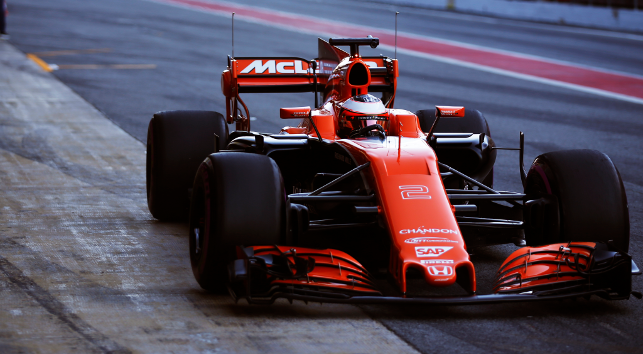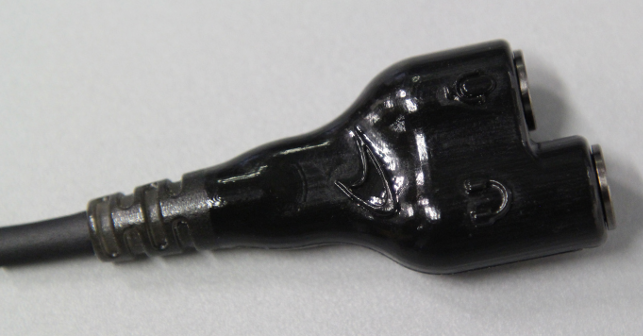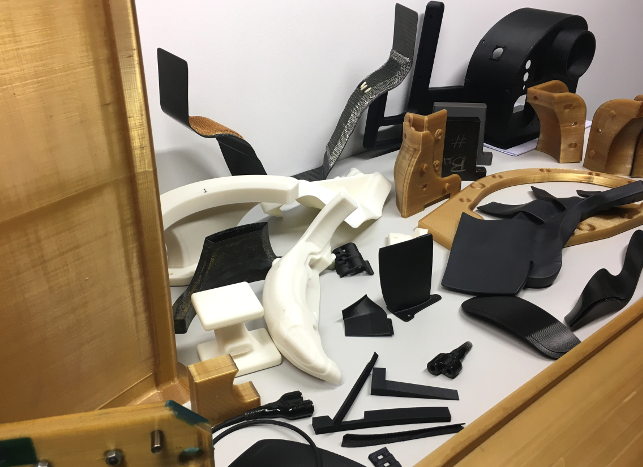
Legendary F1 team McLaren Honda recently opened its doors to DEVELOP3D to showcase the first developments of its fouryear partnership with 3D printing expert Stratasys, and it hasn’t wasted anytime.
A full plethora of Stratasys machines has been installed onsite since the partnership announcement back in January, leading to new digital manufacturing workflows for a company that produces over 6,000 components a week.
The team estimates that the design of the current F1 car evolves every 14 minutes throughout the entire season. With time the crucial factor, new methods of tooling for composites, as well as jigs, fixtures and end-use parts that go straight into the cars are being produced at its Woking HQ.
To further accelerate design and manufacturing cycles, McLaren Honda will be transporting a Stratasys uPrint SE Plus, as part of its trackside equipment, to races around the world, enabling the team to produce parts and tooling on demand from the pit lane.
Although, on the face of it, this desktop machine working away behind the likes of Fernando Alonso in the garage looks like a marketing gimmick, the engineers at McLaren were happy to show us parts they’d worked on specifically as trackside performance enhancements.
Small aero fins and wing tips printed in the pit garage can be attached to the cars to potentially give it an edge in changing conditions.
“We are consistently modifying and improving our Formula 1 car designs, so the ability to test new designs quickly is critical to making the car lighter and more importantly increasing the number of tangible iterations in improved car performance,” says Neil Oatley, design and development director, McLaren Racing.
“If we can bring new developments to the car one race earlier – going from new idea to new part in only a few days – this will be a key factor in making the McLaren MCL32 more competitive.”
Not to waste an opportunity, the feedback from such a high-level client is directly influencing Stratasys’ own engineers and scientists.
When asked, Stratasys EMEA president Andy Middleton said that the relationship will see Stratasys looking to work to solve its engineering challenges in the workshop, in the wind-tunnel, and on the track.
“We believe that this, in turn, will enable us to develop new materials and applications that bring new efficiencies and capabilities to McLaren Racing and other automotive designers and manufacturers,” he says.
With preparation for the next race season already underway, the speed of implementation and the evolution of Stratasys’ technology onsite could mean everything for a team looking to reach the next golden age of its long championship pedigree.
Stratasys – 3D printed race car parts
The current MCL32 race car has already been modified as a result of the partnership, and is running a selection of parts directly benefitting from both Stratasys’ FDM and Polyjet technologies, including:
Hydraulic Line Bracket
A structural bracket to attach the hydraulic line on the MCL32 race car using a Fortus 450mc 3D printer with Stratasys’ carbon-fibre reinforced nylon material Nylon 12CF.
The bracket is said to have been produced in just four hours, compared to an estimated two weeks to create using traditional manufacturing processes.

The hydraulic line bracket was produced using a Fortus 450mc in Nylon 12CF
Flexible Radio Harness Location Boot
Taking advantage of the Stratasys J750 3D printer’s ability to print in flexible materials, McLaren designed and 3D printed a rubber-like boot to join the harness wires for the communication system.
Three different designs were iterated and 3D printed in one day, and the final component was 3D printed in just two hours allowing the new, more comfortable radio harness assembly to be used in the first Grand Prix race of the 2017 season. The custom design also incorporates a McLaren logo.
To efficiently control the brake component temperatures, McLaren Honda 3D printed sacrificial tools to create hollow composite brake cooling ducts.
The wash-out cores, 3D printed using ST-130 soluble material, are clearly one of the standout reasons why McLaren are beaming about the partnership, as it boosts its composites production process massively without the need for time consuming tooling.
Developed specifically for the application, and then wrapped with carbon fibre-reinforced composite material the parts are then autoclave-cured at elevated temperatures.
The final result is a tubular structure with very smooth internal surface finishes to ensure the required airflow to brakes, whilst maintaining maximum aerodynamic and car performance.

The radio harness location boot is a flexible, rubber-like part
Carbon Fibre Composite Brake Cooling Ducts
Rear Wing Flap
Flaps, fins and edges are a constantly evolving quirk of an F1 car, with each one changing to suit track and even weather conditions as the teams look to shave off hundredths of a second from their lap times.
A large rear wing flap extension designed to increase rear downforce was manufactured in carbon fibre reinforced composites using a 3D printed lay-up tool produced on the FDM-based Fortus 900mc 3D printer.
The team 3D printed the 900mm wide, high temperature (177°C) mould in ULTEM 1010 for the autoclavecured composite structure in just three days, saving time in a critical limited testing period.

A large rear wing flap extension was created with the help of a 3D printed mould in ULTEM 1010

A selection of 3D printed parts that have been produced on McLaren’s onsite Stratasys machines






